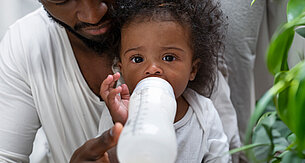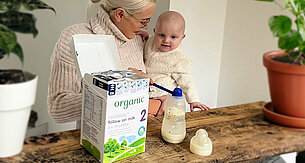Choosing and Changing formula milks

What formula milk should I choose?
All formula milks meet strict regulations to make sure they are nutritionally adequate for your baby - but choosing one can still be complicated. Here's what you need to know.
If you decide to use formula milk to feed your little one (either as a supplement to breastmilk or as a substitute), choosing one will be a big decision so it’s a good idea to seek advice from your healthcare professional.
Today’s formula milks offer high-quality nutrition for babies (they're the most strictly regulated of all food stuffs!). Formula milks are usually based on either cows’ milk or goats’ milk, with carefully adjusted carbohydrate, protein and fat levels, and are enriched with specific levels of vitamins, minerals and nutrients; however they aren’t able to provide all the protective factors found in breast milk.
Why do milk packs all have strong statements on breastfeeding?
Breastfeeding is best for babies, and although the Government and health authorities recognise that not all babies can be breastfed, they want to ensure that parents planning to bottle feed have considered their decision very carefully. All formula milk manufacturers are therefore required by law to also provide information about breastfeeding.
Milks in the first year
You'll generally find there are three types of formula milk available that meet the nutritional requirements of healthy babies. These are:
- First infant milk 1 - suitable for use from birth onwards. It is the only safe alternative to breastmilk for babies under 6 months
- Follow on milk 2 - for use from 6 months, as part of a mixed weaning diet
- Growing up milk 3 - from 12+ months onwards, as part of a mixed diet
Healthy Start vouchers
‘Healthy Start' vouchers can be used to buy cows’ milk based infant milks (those that say they are suitable from birth), but not follow on milk or growing up milk.
Are there any special milks I can use for my baby?
Specific formulas are available for babies with special dietary needs, such as allergies, intolerances or feeding problems such as colic, constipation or reflux, but you should only use these on the advice of your GP or healthcare professional. If you think your baby needs a particular type of special milk, you should always discuss it with them.
Soya-based formula, in particular, should only be given to babies if recommended by your healthcare professional (read more about this on the NHS Choices website). They state: For the first six months, it's best to give your baby only breast milk or infant formula.
Breastfeeding is recommended because breastmilk provides all the nutrients that a baby needs for healthy development during this time. There is no health benefit in giving soya-based infant formula to a healthy baby.
Should I use the same stage of formula milk throughout my baby's first year of life?
If your baby is happy, healthy, gaining weight steadily and has regular bowel movements, you don't need to change the formula milk you are using in this first year. If you have any concerns about your baby's feeding, or if you are thinking about changing the brand or type of milk you use, it's best to speak to your health visitor or GP about it first.
Your baby should drink either breastmilk or infant milk for at least the first year of life. From 6 months, however, you may choose to use a follow-on milk. These milks, which are usually labelled as stage 2, are formulated to be used alongside a varied weaning diet and have been developed to meet the nutritional needs of older infants and contain higher levels of some nutrients such as Vitamin D and iron.
From 12 months, when babies become active toddlers, you may wish to switch to a growing up milk. Growing up milks are specially formulated to provide the extra iron and vitamins that whole cows’ milk may be too low in to fully meet a toddler’s needs at that age, and can provide the nutrition needed to support growth and increased activity.
Changing your formula milk
If you decide you want to change your baby’s formula milk to a different brand or stage (e.g. from infant to follow-on milk when they reach 6 months), or even if your current brand launches a new formulation, there are a couple of things to bear in mind.
First is the type of protein-based formula milk your baby is currently drinking. There are four main types: cows’ milk based, goats’ milk based, soya-based and hydrolysed protein formulas. Unless you've been advised by your GP or health visitor to switch from one type to another (usually because of a suspected allergy), you'll probably want to stick with the type of formula you're already using. For most parents, this is a cows’ milk-based formula.
You'll also want to consider your baby's age. If you've already started weaning, the transition from one formula to another can be quite quick. Try changing one feed on day one, followed by two feeds on day two, and so on until all feeds have been changed to the new formula.
If your baby is still only having milk, the transition may take a little longer. To start with, try gradually switching just one feed on both days one and two, and then switch two feeds on days three and four, and so on.
If you are changing to a different brand, instead of just a different stage of formula, you may want to swap as slowly as one feed every 2-3 days to allow your baby time to adjust to the new formulation.
When is it safe to introduce cows' milk?
Babies shouldn’t have cows' milk as a main milk drink until after age one. However, once you’ve started introducing solid foods at around 6 months old, it’s fine to use small quantities of whole cows' milk to mix your baby's foods, as long as there's been no evidence of an allergy.
It's best not to give semi-skimmed cows' milk as a drink before age 2; it doesn’t contain enough vitamin A, and your growing toddler needs the fat and calories whole milk contains. After age 2, it's fine to switch to semi-skimmed if your child is eating well and growing well. Skimmed milk is best avoided until age 5 or later, because it doesn't provide enough calories for young, growing bodies.
Organic milk has been shown to have higher levels of some essential nutrients, including omega 3 fatty acids and antioxidants, compared with non-organic milk.
Taking baby milk on holiday
It’s worth doing some research before you travel to see whether your baby's usual formula milk will be available at your destination (and whether it's got the same ingredients as it does at home). To be on the safe side, it’s often best to take all the formula you'll need along with you, making sure you have enough to cover any delays. You’ll also need to pack your feeding equipment, including something to sterilise all the bottles and teats, if baby is under 6 months of age.
Remember that tap water should always be boiled before you prepare a feed. If you're not sure the local tap water is safe to use, you can make up your baby's formula using boiled bottled water; just choose a brand that has no more than 200 mg per litre of sodium (‘Na’), and no more than 250mg per litre of sulphate (‘SO’ or ‘SO4’)





